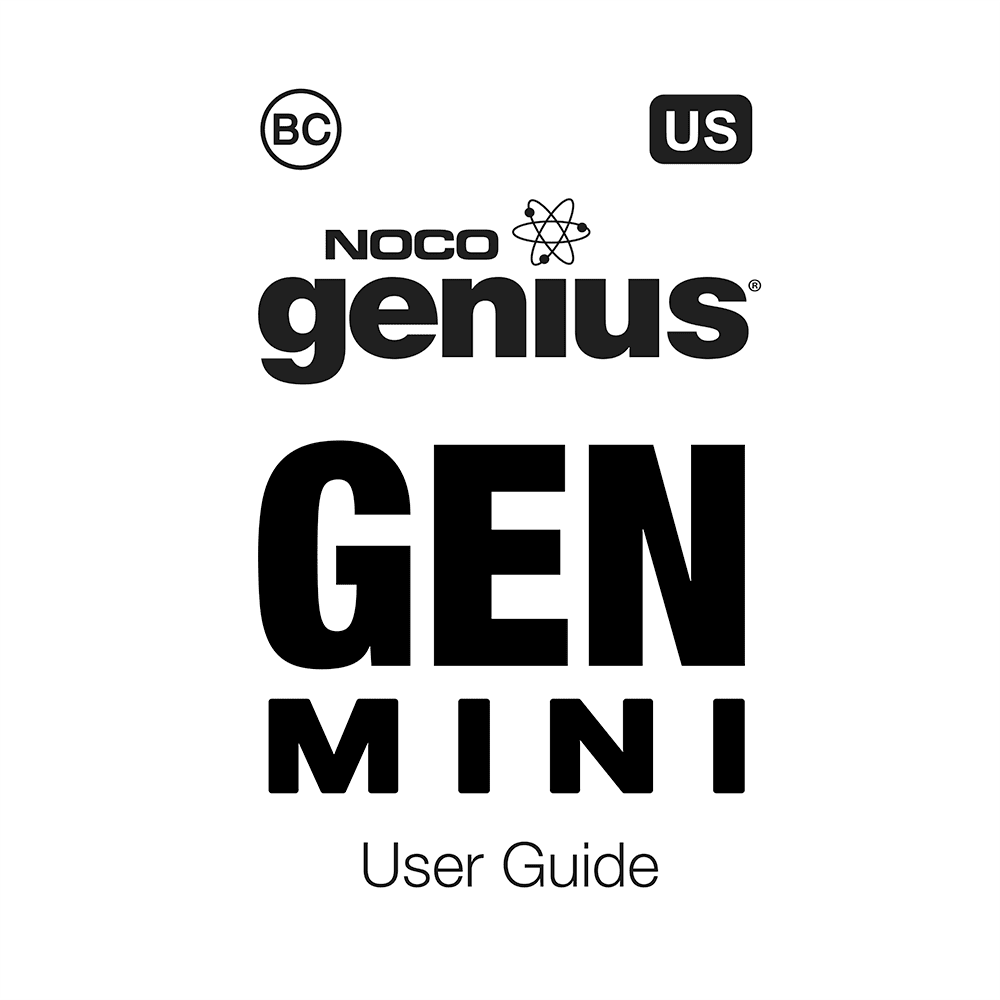NOCO GENM1 1-Bank 4A On-Board Battery Charger User Guide
Download PDF user manual for NOCO GENM1 (GEN Mini 1) 1-Bank 4-Amp On-Board Marine Battery Charger (EN|ES|FR) 44 pages NPD1112315A 2015 zip
Description
This PDF user guide is for the NOCO GENM1 on-board battery charger.
About the Item
NOCO GENM1 (GEN Mini 1) 1-Bank 4-Amp Mini Series On-Board Marine Battery Charger
UPC: 0-46221-12072-1
The GENM1 is an On-Board Battery Charger for charging and maintaining a single 12-volt Marine, Starter or Deep-Cycle battery. It’s waterproof, shock and vibration resistant rugged design can be mounted directly onto a variety of applications, including a boat, trolling motor or generator, as well as, a full range of electric vehicles and industrial equipment. It monitors battery activity for safe, fast and efficient charging of Wet, Gel, AGM and Maintenance Free batteries without the worry of overcharging. And it’s one of the most advanced charging systems designed for improved battery performance and longevity.
Document(s) available
(PDF) USER GUIDE
Available languages
ENGLISH | ESPAÑOL | FRANÇAIS
SUMMARY OF CONTENTS
– What’s In The Box
– Warning
– Use The Following Precautions When You Work Near Lead-Acid Batteries
– How to use NOCO GENM1 (GEN Mini 1)
– Before Charging
– Locating Battery Charger
– Battery Specs
– Ignition Protected
– Connecting To The Battery
– How To Start Charging
– Charger Maintenance
– Understanding The LED:
When Charging RED – When the battery is charging, the CHARGE LED will be illuminated RED. The CHARGE LED will remain a solid RED color (not blinking) until the battery is fully charged.
When Charged GREEN – When the battery is fully charged, the CHARGE LED will be illuminated GREEN. The CHARGE LED will remain a solid GREEN color (not blinking) until either the battery charger is disconnected or the battery becomes discharged.
Reverse Polarity ORANGE – If a Reverse Polarity condition exists, the ORANGE ERROR LED will illuminate. This ERROR condition will be displayed whether the charger is plugged in or disconnected from an AC power source. Reverse the battery connections to fix this ERROR.
Error Condition FLASHING – If an ERROR condition exists, all LEDs will flash. There are several reasons an ERROR condition could exist. For help troubleshooting ERROR conditions, see the section entitled TROUBLESHOOTING.
– Charging Times
– Charging Steps:
Step 1 & 2: Analyze & Diagnose
Step 3: Recovery
Step 4: Initialize
Step 5: Bulk
Step 6: Absorption
Step 7: Optimization
Step 8: Maintenance
– Battery Testing And Diagnostics
– Technical Specifications.
– Troubleshooting:
WHEN FLASHING LEDS ILLUMINATE.
When the battery charger detects an ERROR condition, the CHARGE LED and ERROR LED will flash. If you are seeing this ERROR condition, it could be the result of one of the following situations:
– Battery Voltage Incompatibility.
Check to make sure you have a 12V battery. This battery charger is for 12V batteries only. If you attempting to charge a battery that is other than 12V, it could cause this ERROR condition. Charge the appropriate battery to resolve this ERROR condition.
– Low Voltage Battery.
If the battery voltage is below 2.0VDC (12V), it could cause this ERROR condition. In this situation, the battery charger has determined that the battery voltage is too low to begin a normal charge cycle. To increase the battery voltage and allow the battery charger to begin charging, you will need to jump start the battery.
– Abnormality Protection.
This ERROR condition is the result of the battery charger being in the Bulk mode for more than eighty (80) hours. This ERROR condition is the result of a bad battery. To resolve this ERROR condition, take the battery to a local battery store for an evaluation.
– Blown Fuse In Battery Connector Harness.
Check the fuse in the battery connector harness. If the fuse in the battery connector harness has blown, it could cause this ERROR condition. Replace the fuse with a 15A Automotive Blade Fuse to resolve this ERROR condition.
– Corrosion On Battery Terminals.
Check the battery connections for battery corrosion. If battery corrosion is present on the battery connections, it could cause this ERROR condition. Remove the battery corrosion to resolve this ERROR condition.
– Loose Battery Connections.
Check the battery connections to the battery. If the battery connections are loose, it could cause this ERROR condition. Tighten the battery connections to resolve this ERROR condition.
– Sulfated, Damaged, Or Weak Battery.
If you have checked all other possible ERROR conditions and cannot clear the ERROR, it is probably the result of a sulfated, damaged, or weak battery. To properly diagnose a sulfated, damaged, or weak battery, take the battery to a local battery store for an evaluation. The battery store will advise if the battery can be charged or needs replaced.
WHEN NO LIGHTS COME ON WHEN THE BATTERY CHARGER IS PLUGGED INTO AN ELECTRICAL OUTLET.
– WEAK AC CONNECTION.
Check if the AC outlet has power. If the AC outlet has no or limited power, it could cause this condition. Plug a light into the AC outlet to check if the outlet has power. If the light is extremely dim, this could be the result of limited AC power. The battery charger is designed for use at 70-130VAC. If there is no power or the power is below 70VAC, locate another AC outlet that has sufficient power to resolve this ERROR condition.
– Troubleshooting Tips:
TESTING TO SEE IF CHARGER IS CHARGING.
Before applying AC power to the charger, measure the battery voltage with a digital voltmeter and write the value down. Plug the battery charger into an electrical outlet. Wait at least thirty (30) seconds and measure the battery voltage again with the digital voltmeter. The battery voltage should be higher than the previous value and slowly moving up.
ABNORMALITY PROTECTION.
If the battery charger is in the Bulk mode for more than 80 hours, the battery charger will go into an ERROR condition. This feature prevents damage if the battery is faulty.
LOW BATTERY.
If you have a severely discharged battery, a battery that is below 9.0VDC, it could be the result of a defective battery. Batteries that have been severely discharged as a result of an accidental load should respond quickly when current is applied to the battery, resulting in a sharp increase in battery voltage.
Table 1: Recommended minimum AWG size for extension cords for battery chargers.
Why download the Manual?
This user guide provides all the information from NOCO about the GENM1 on-board battery charger, as detailed in the table of contents. Reading it completely will address most questions you might have. You can download and save it for offline use, including viewing it on your device or printing it for your convenience if you prefer a paper version.
How to download the Manual?
Download it by clicking the button below
Helped you out?
Glad to hear that. It would be awesome if you could . . .


